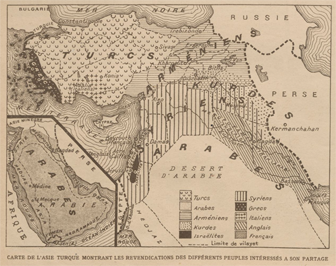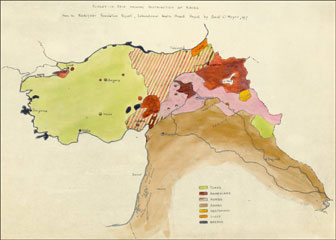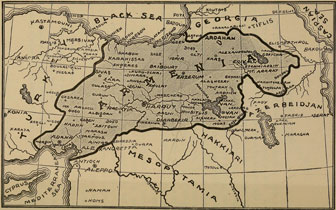The Armenian Question on the Map
Having lived in the southern Caucasus region and eastern Asia Minor for as long as three thousand years, the Armenians are one of the most ancient ethnocultural communities of the Euroasian space. Since the Armenia is the first state to adopt Christianity as a state religion in AD 301, the Armenians formed later, by the 19th century, the largest Christian population to survive in the Muslim-dominated Middle East. Today, the Armenian population is between five and eight million persons, with a large diaspora and with about three and one-half million living in the Republic of Armenia.
For a nation which has dramatically lost the control over its homeland for centuries, the emotional relation between the traditional homeland and the Armenian national identity is very strong and constitute an essential element of the Armenian self-definition.
The brutal destruction of the Armenian community of the western half of the traditional homeland during the « Armenian Genocide » at the beginning of the 20th century explains the place of this homeland in the general Armenian imaginary even today and explains why the territorial question (« the Armenian lands ») is so important for the Armenian political elites.
However, the inextricable relation between the national territory and the national identity is explained too by another type of territory: the historical one.
The space of the Armenian ethnogenesis is more larger than its traditional homeland and in order to understand the Armenian history we have to identify the Armenian Golden Age.
For Armenia, this Golden Age seems to be, territorially speaking, the reign of the king Tigranes the Great (95-55 BC). At its zenith, Tigranes’ Armenia was extended outside of the Armenian Highlands over the regions that are now southeastern Turkey, Lebanon, northern Syria and Iraq, and northwestern Iran.
Few decades after the adoption of the Christianity as a state religion in AD 301, the Kingdom of Armenia is divided between the Byzantine Empire and the Sassanid Persia. Later, in the 7th century, the entirety of Armenia falls under Arab-Islamic rule and Armenia will remain for 200 years under foreign domination.
In 9th century, the Bagratid kings regained the independence of the Armenian kingdom and managed to extend the borders of this Armenian polity, but in the 11th century, the Bagratid Armenia had to be destroyed and divided between the Byzantine Empire and the Seljuk Turks.
In this situation, the Armenian refugees fleeing the Seljuk invasion founded a new Armenian state in Cilicia, a region located outside of the traditional Armenian homeland and distinct from the Tigranes the Great’s ancient Armenia. A prosperous state for three centuries, the new Kingdom of Armenia fell in 1375 under the Mamluk rule.
After the fall of the last Armenian state in Cilicia, the Armenian world came under the rule of the rivaling Ottoman and Persian empires. By the mid 19th century, the eastern part of the traditional Armenian homeland has been annexed by the Christian Russia, while the western Armenia remained under the Muslim Ottoman rule.
As Christians under a strict Muslim system, the Ottoman Armenian community faced religious and ethnic discrimination and persecutions. In this context, the Armenian nationalists have tried to identify a solution to this « Armenian question »: autonomy inside the Ottoman empire or independence as « a free, independent and united » Armenian state.
As a result of the Russo-Turkish war of 1877-78, Russia annexed again Armenian territories and forced the Turkey to improve the political status of the Armenians from the Ottoman « provinces inhabited by Armenians ».
In February 1914, the Ottomans accepted the Armenian reform package, a reform plan that envisaged the creation of two provinces in the Ottoman Armenia as a solution to the « Armenian question ». But in December 1914, this project was abandoned and the Ottomans have found another solution...
The World War I has dramatically touched the Armenian nation in Turkey. Seen as a potentially traitorous fifth column, the Turkish Armenian community has been identified by the Ottoman government as the internal enemy and, in order to avoid further problems with this enemy, the Ottoman state has decided to relocate the Armenian community to Syria and Mesopotamia.
According to modern estimates, it is believed that up to three-quarters of the entire Ottoman Armenian population (up to 1.5 million persons) died as a direct consequence of this ethnic-based punitive initiative. Regarded as a Genocide by the Armenians, the brutal destruction of the Ottoman Armenian community represented the main argument for the establishment of an Armenian safe haven.
In this context, in 1919, at the Paris Peace Conference, the Armenian political elite has claimed, after the creation of a small Armenian republic in Eastern Armenia (former Russian-controlled Armenia), sovereignty over all of the Armenian lands and the establishment of an independent and united Armenian state « from sea to sea ».
The Armenians’ claims have been rejected by the Great Powers, but the idea of a large Armenian state had its supporters: Woodrow Wilson, the American president, proposed a new western boundary for this Armenian republic (Treaty of Sèvres, 1920). According to Wilson, the Republic of Armenia had to annex too so-called Western Armenia (known later as "Wilsonian Armenia"), namely the Ottoman vilayets of Erzurum, Bitlis and Van, and the pontic coast with the port of Trabzon.
However, the outbreak of the Turkish-Armenian War had to dramatically change the situation: defeated, Armenia signed the Treaty of Alexandropol in November 1920, the Ottoman Empire (Turkey) retook the Western Armenia and the Wilsonian project was abandoned.
Later, the Russian/Soviet occupation of the Eastern Armenia and the Treaty of Lausanne (1923) put a definitive end to the project of an united Armenian state. The Eastern Armenia became eventually a Soviet state and the Wilsonian Armenia became a Turkish realm with no sizable Armenian population.
At the end of the 20th Century, the decline and then the disappearance of the Soviet Union had to substantially modify the nature of the relations between the Armenian State and the Armenians from the neighboring countries and, nolens volens, the "Armenian question" reappeared on the Armenian Government’s agenda.
In Azerbaijan, for example, the Armenians from the predominantly Armenian-populated region of Nagorno-Karabakh claimed the reunion with the Armenia and, after a civil war, they managed to establish a de facto independent state, the "Republic of Artsakh," as a first step toward reunification. The Armenia endorsed a popular vote by the residents of Karabakh to decide their future, but the final status of the region had to be determined later. However, the situation is still confused in the region: at the end of September 2020, the Azerbaijan’s Government retook the military initiative against the Armenian rebels from Nagorno-Karabakh and, after less than two months of clashes, the "Republic of Artsakh” lost almost 3/4 of its prewar claimed territories....
Prisoner of its ingrate geography and caught between a hostile Turkey and a bellicose Azerbaijan, the today Republic of Armenia seems incapable of managing its territorial dilemmas. In this context, the chances for a political solution to an historical "Armenian question" are zero to none.
*
Present-day Republic of Armenia represents only a small part of the traditional Armenian homeland. According to the Armenian historians, this traditional homeland occupied from the beginning of the nation’s history the so-called Armenian Highlands (located in the southern part of the Caucasus region and the eastern part of the Anatolian peninsula) and the adjacent regions.








A Story in Seven Maps by Cristian Ionita















